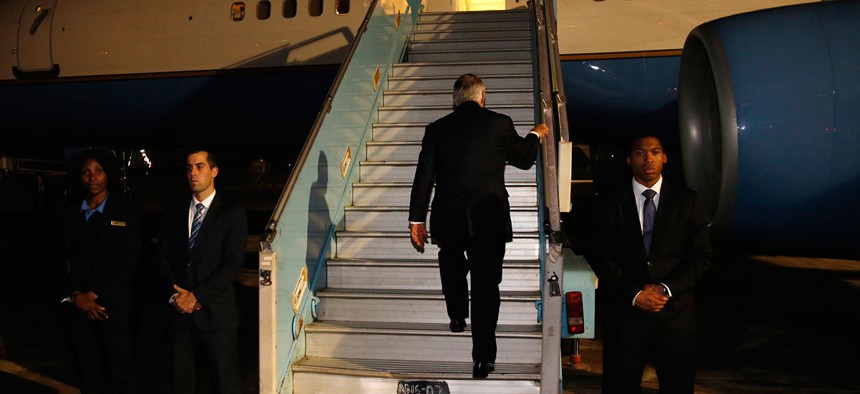Their Final Disagreement: How Trump Fired Tillerson
The White House’s timeline of when the secretary of state was told differs from the State Department’s.
Donald Trump and Rex Tillerson disagreed on global trade, climate change, NATO, the nuclear deal with Iran, talks with North Korea, Qatar’s impasse with its neighbors, and, ultimately, even how the president fired his secretary of state.
The White House said Tuesday that Tillerson was informed last Friday that he would be replaced as secretary of state. But the statement released Tuesday by Steve Goldstein, the undersecretary of state for public diplomacy, suggested Tillerson did not see it coming until he saw the president’s tweet Tuesday morning that he would be replaced by Mike Pompeo, the CIA director. Goldstein himself has been fired since making the statement.
The AP quoted two unnamed senior department officials as saying Tillerson “received a call from John Kelly, Trump’s chief of staff, on Friday, but was only told that there might be a presidential tweet that would concern him. Kelly didn’t tell Tillerson what the tweet might say or when it might actually publish.” In public remarks Tuesday, Trump said he’d been considering replacing Tillerson for some time, but made the final decision recently, and “by myself.” A State Department official, speaking on condition of anonymity, said there was little clarity at the department over what was happening or who was in charge. “We are all waiting for something official,” the official said.
Tillerson’s ouster comes as the Trump administration shifts gears on its major foreign-policy challenge. Last Thursday, Trump announced he was ready to meet with North Korean leader Kim Jong Un. Just hours earlier Tillerson had said in Ethiopia: “We are a long ways from negotiations” with North Korea. That was only the most recent occasion in which the president and the secretary of state appeared to be at odds over the issue. Until Thursday, it was Tillerson who had advocated dialogue with the North Koreans while Trump and his aides had publicly favored a tougher approach, and cast doubt on the use of talking.
Trump and Tillerson also disagreed publicly on the future of the nuclear deal with Iran. “We were not really thinking the same,” Trump said Tuesday about his differences with Tillerson over the agreement. “With Mike, Mike Pompeo, we have a very similar thought process.” Trump had called the agreement “the worst deal in history” and wanted the U.S. to withdraw from it. Tillerson said the deal was flawed, but that it did what it was supposed to: freeze Iran’s nuclear program. He had been working with U.S. allies who are part of the agreement to find a solution to the impasse caused by Trump’s position.
They were also divided on NATO: Trump dismissed it as irrelevant while, early in his presidency, appearing to condition U.S. support for its NATO allies on their defense expenditures. Tillerson tried to soothe the fears this caused within the alliance, which were being exacerbated by Russia’s increasingly muscular foreign policy.
On Qatar, Trump appeared to blame Doha for the impasse with its Gulf neighbors (and for funding terrorism), while Tillerson supported a negotiated settlement among America’s Arab allies—who include Qatar as well as the Saudi and UAE-led coalition pushing to isolate the country.
Tillerson cautioned the president against moving the U.S. embassy to Jerusalem, which Trump did anyway; and he wanted the U.S. to stay in the Trans-Pacific Partnership trade agreement and the Paris climate accord, both of which Trump withdrew the U.S. from. Most recently, Trump and Tillerson differed on Russia’s role in the attempted assassination in the U.K. of a former Russian spy and his daughter. Tillerson supported the U.K. government’s assessment that Russia was behind the attack. Trump, who has been reluctant to criticize Russia publicly, has hedged instead of echoing that line.
The manner in which Tillerson was ousted—via Twitter—once again shows Trump’s reluctance to directly tell people to go. He didn’t fire Tom Price, the secretary for Health and Human Services, who resigned last fall. He has railed against Attorney General Jeff Sessions, but stopped short of pushing him out.
Tillerson cut short by a day a trip he was on to Africa and returned to Washington. He told reporters en route to Washington that he was tired after becoming ill in Ethiopia and after working across multiple time zones on North Korea. The AP pointed out: “There were no obvious signs from his behavior or his aides on the plane that his departure was imminent.” Hours later, he was gone.



